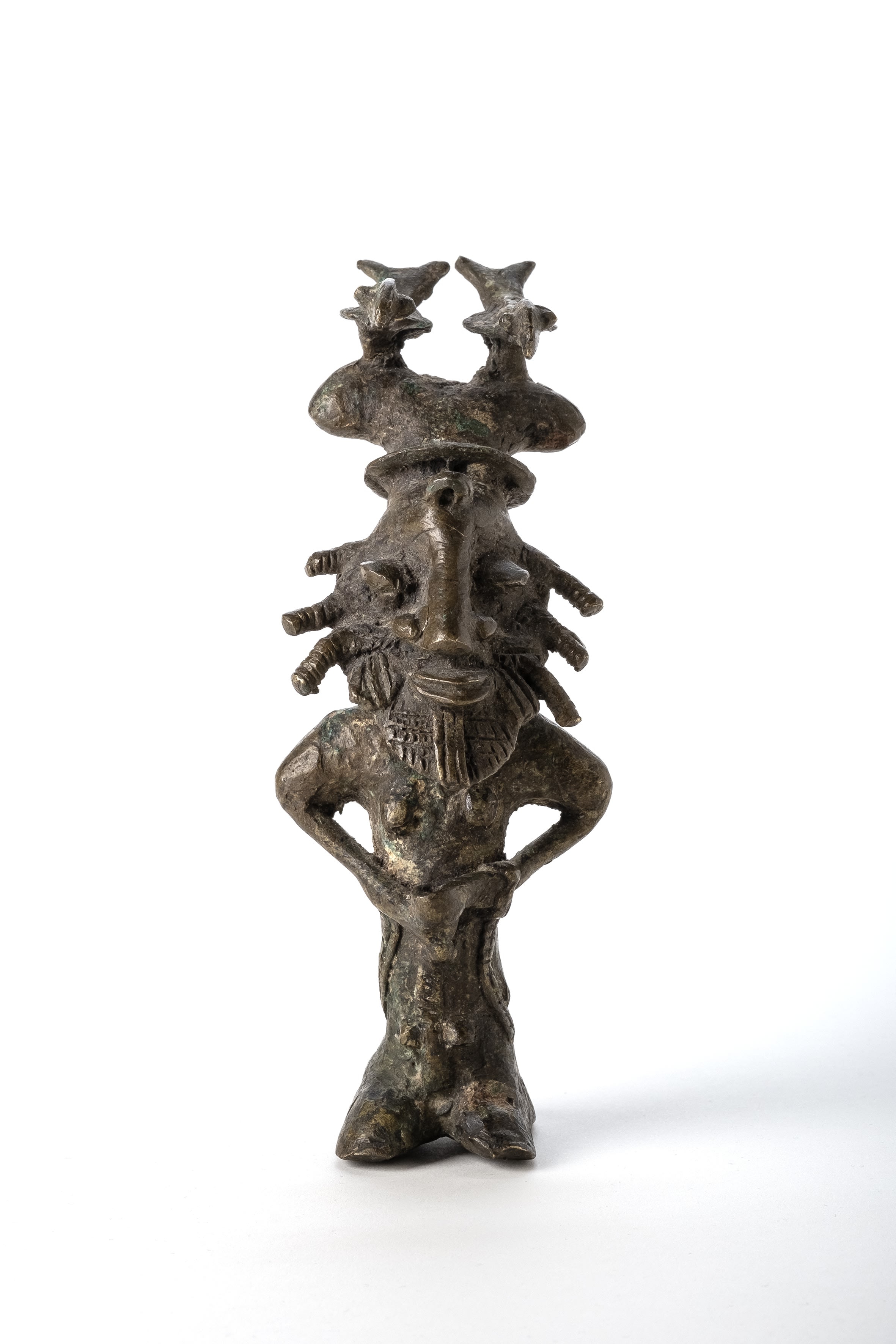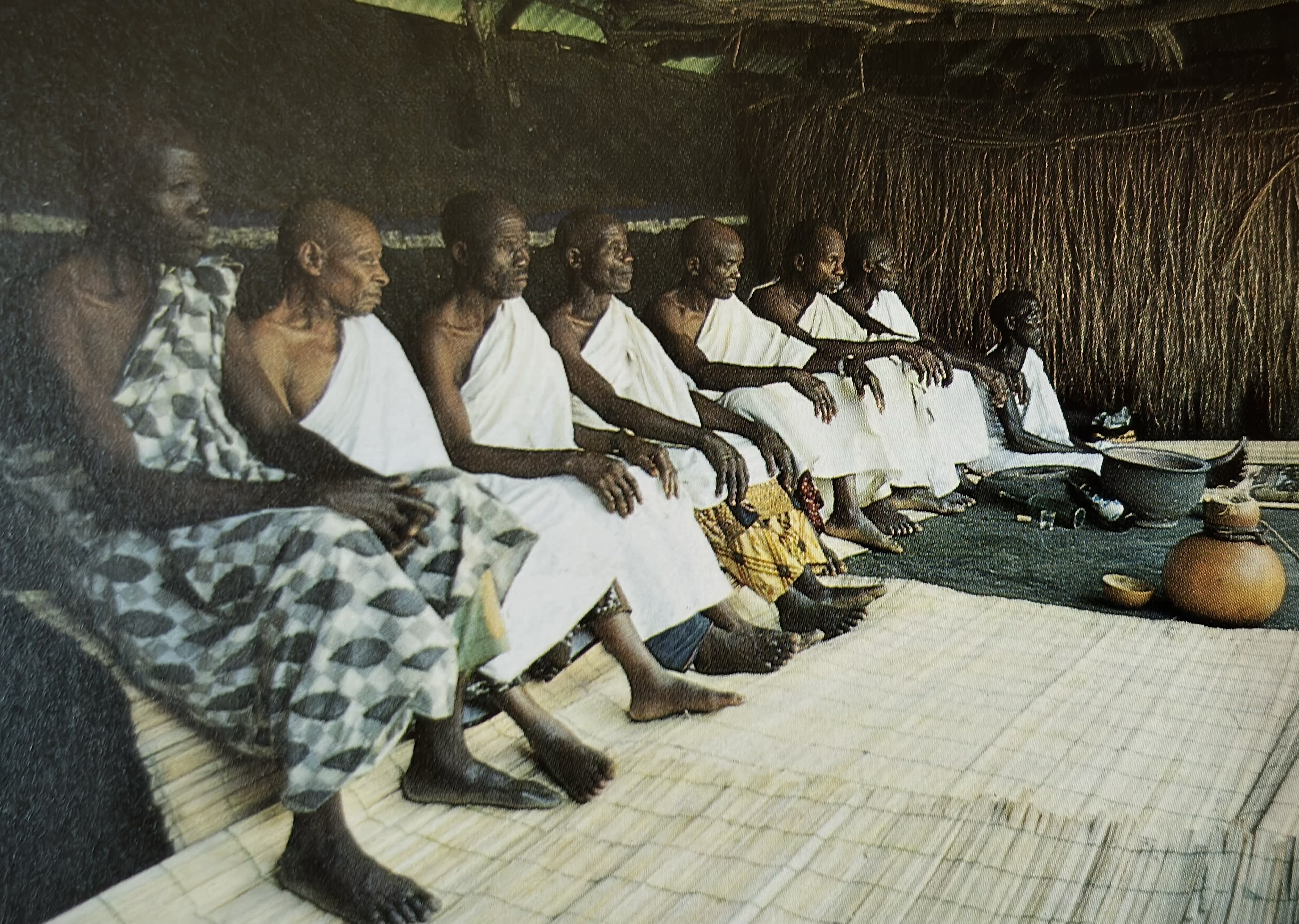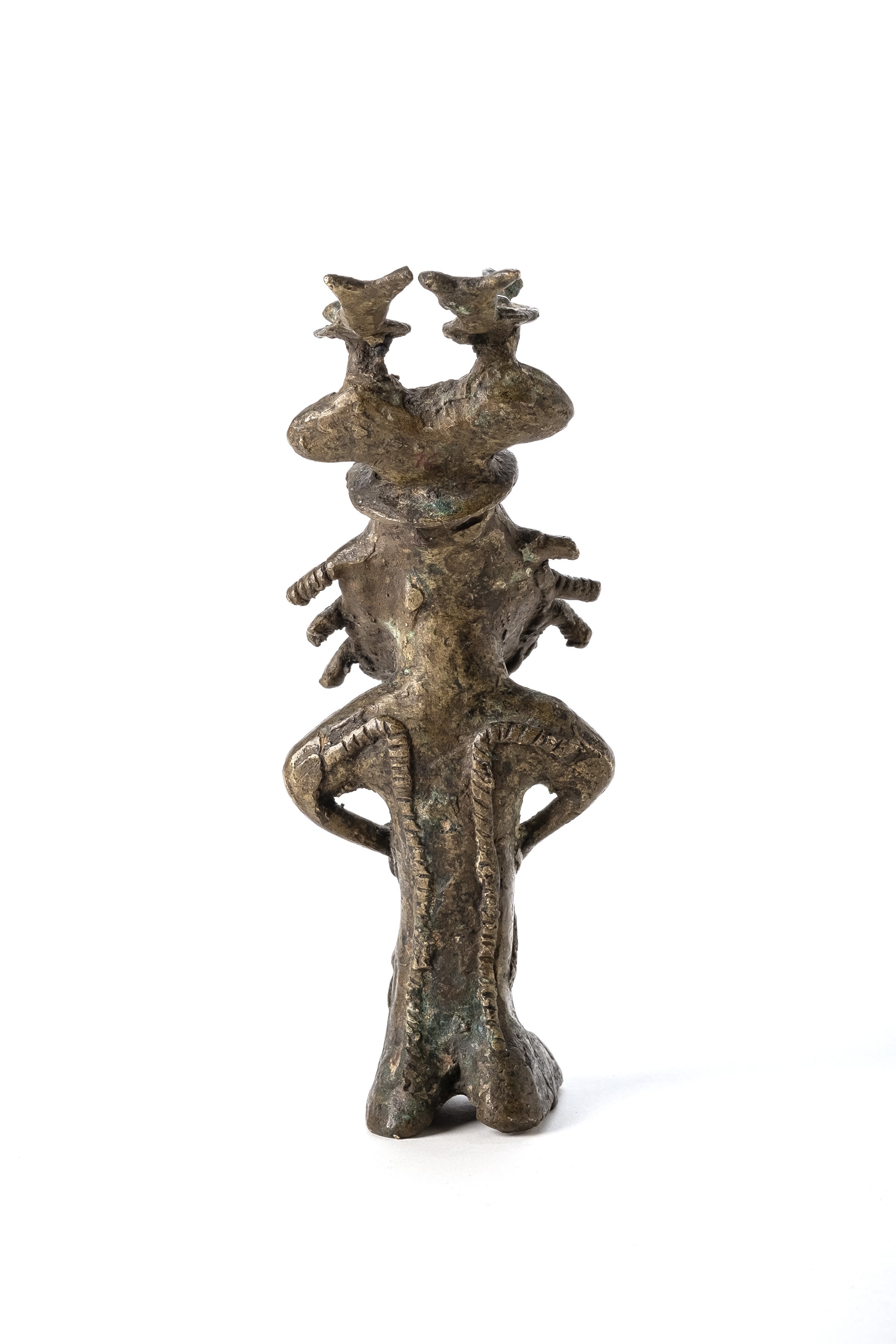
FIGURE "ONILE"
Anonymous Yoruba artist
Abeokuta, Nigeria
19th century or earlier
Copper alloy. 16,5 cm
Provenance:
Acquired from a Hausa trader, Mallam Abba Kallah
Collected in the 1960s by Balint B. Denes, who formed the “Alexandra Collection of African Arts”
The Balint B. Denes Collection, Arizona, USA, 2022
Anderson & Garland, Newcastle, “The Collector’s Auction”, 30 June 2022, lot 946.
Duende Art Projects, Antwerp, Belgium, 2022

Seen the typical hand gesture (the ogboni greeting sign), this copper-alloy seated figure can be identified as an onile. It was the collective property of a Yoruba ogboni society and kept in the shrine of their house. Called onile (“Owner-of-the-house”), it was cast at the founding of a settlement and the establishment of an ogboni lodge. A male-female pair of onile symbolized the original progenitors, the male and female members of the lodge, and by extension the entire community. The ogboni (or osugbo) society was one of the most important institutions of the Yoruba. Consisting ideally of the eldest and wisest male and female elders in a community, it decided judicial cases, served as an appeals court for village cases, and meted out punishment for all criminals condemned to death. It also controlled the selection, installation, abdication, and funeral of kings. Osugbo thus served a wide variety of crucial political, judicial, and religious functions. In the Ijebu region the head of a town, whether chief or king, traditionally was called ‘olorin’, meaning ‘Owner-of-the-Metal’ – a specific reference to the metal ritual objects such as the onile that symbolized the founding of the settlement and the ogboni lodge.

Ogboni members seated in their lodge (iledi). Photographed by H.J. Drewal in Ibese, 1977. Published in Drewal (Henry John), Pemberton III (John), Abiodun (Rowland), “Yoruba: Nine Centuries of African Art and Thought”, expo cat., edited by Allen Wardwell. Published and distributed by The Center for African Art and Harry N. Abrams, Inc., 1989, p. 24, fig. 19.

An apena (spokesman) giving the sacred sign: the kneeling position and ogboni sign is a greeting that communicates respect, obedience, deference, and devotion, as well as blessing. Photo by M.T. Drewal in Imosan, Ijebu, Nigeria, 1986. Published in Drewal (Henry John), Pemberton III (John), Abiodun (Rowland), “Yoruba: Nine Centuries of African Art and Thought”, expo cat., edited by Allen Wardwell. Published and distributed by The Center for African Art and Harry N. Abrams, Inc., 1989, p. 130, fig. 140.

This charming statue originates from the Ogundipe workshop in Abeokuta (Egba-Yoruba). The Dutch Yoruba expert Hans Witte wrote about the founder and history of this atelier: “Alatishe Ogundipe came from Idomowo, the bronze-casting district of Ijebu-Ode. Around 1840-50 he settled in the Ikija district of Abeokuta where he and his successors continued in an Ijebu style that gradually picked up elements from the Egba and probably Oyo traditions. When Alatishe arrived, Abeokuta was rapidly growing from a hunter’s camp into the capital of the Egba. It also was a place of refuge for the surviving inhabitants of cities that were destroyed during that long period of incessant inter-Yoruba wars that lasted until the end of the 19th century. Alatishe Ogundipe was not only a bronze-caster but also a warlord and as such he gained himself a reputation in the wars with Dahomey. As a successful soldier he could mix with the military and social elite where his prestige objects in copper alloy were much in demand. Several generations of successors continued his style that in the process picked up many elements from the Egba and probably the Oyo traditions. With our actual knowledge this development is difficult to trace. There is not one single object that can be traced with certainty to Alatishe himself. William Fagg proposed in Christie’s catalogue of June 17th, 1980, lot 237 that an ‘onile’ figure is perhaps from Alatishe himself.” Hans Witte agrees this onile is made in a style that is very close to that of certain Ijebu workshops, but states it was probably made in Abeokuta because the figure has in each hand a staff of a type that was used there. That makes the Christie’s onile figure likely a product of the Ogundipe tradition, but does not specifically indicate Alatishe. Two couples from the same caster can be identified, one previously in the collection of Karl-Ferdinand Schadler, the others published by Theo Dobbelman and Hans Witte. Characteristics are the bulging eyes, broad nostrils, large beard, lateral stylized tresses of hair, and birds placed on top of the horned coiffure. In almost all instances of Yoruba ritual art, birds were references to the mystical power of women.

into the capital of the Egba. It also was a place of refuge for the surviving inhabitants of cities that were destroyed during that long period of incessant inter-Yoruba wars that lasted until the end of the 19th century. Alatishe Ogundipe was not only a bronze-caster but also a warlord and as such he gained himself a reputation in the wars with Dahomey. As a successful soldier he could mix with the military and social elite where his prestige objects in copper alloy were much in demand. Several generations of successors continued his style that in the process picked up many elements from the Egba and probably the Oyo traditions. With our actual knowledge this development is difficult to trace. There is not one single object that can be traced with certainty to Alatishe himself. William Fagg proposed in Christie’s catalogue of June 17th, 1980, lot 237 that an ‘onile’ figure is perhaps from Alatishe himself.” Hans Witte agrees this onile is made in a style that is very close to that of certain Ijebu workshops, but states it was probably made in Abeokuta because the figure has in each hand a staff of a type that was used there. That makes the Christie’s onile figure likely a product of the Ogundipe tradition, but does not specifically indicate Alatishe. Two couples from the same caster can be identified, one previously in the collection of Karl-Ferdinand Schadler, the others published by Theo Dobbelman and Hans Witte. Characteristics are the bulging eyes, broad nostrils, large beard, lateral stylized tresses of hair, and birds placed on top of the horned coiffure. In almost all instances of Yoruba ritual art, birds were references to the mystical power of women.